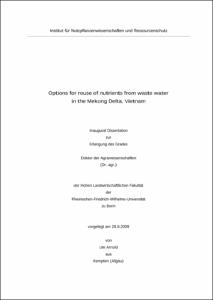Arnold, Ute: Options for reuse of nutrients from waste water in the Mekong Delta, Vietnam. - Bonn, 2010. - Dissertation, Rheinische Friedrich-Wilhelms-Universität Bonn.
Online-Ausgabe in bonndoc: https://nbn-resolving.org/urn:nbn:de:hbz:5N-23856
Online-Ausgabe in bonndoc: https://nbn-resolving.org/urn:nbn:de:hbz:5N-23856
@phdthesis{handle:20.500.11811/4237,
urn: https://nbn-resolving.org/urn:nbn:de:hbz:5N-23856,
author = {{Ute Arnold}},
title = {Options for reuse of nutrients from waste water in the Mekong Delta, Vietnam},
school = {Rheinische Friedrich-Wilhelms-Universität Bonn},
year = 2010,
month = dec,
volume = 42,
note = {Different options for wastewater treatment in the Mekong Delta were studied to recycle nutrients efficiently for later use in agriculture.
Due to an even distribution of nutrients between animal and human excrements in the Mekong Delta, both flows were examined regarding their potentials for nutrient recycling as well as the associated risks.
Animal slurry was treated anaerobically in two different types of existing small biogas digesters (fixed-dome and plastic-tube reactors, 6-8 m3). Analysis showed superior performance of fixed-dome reactors in reducing COD, suspended solids, E.coli and helminths whereas other parameters, e.g. BOD5 were degraded comparably. Due to short hydraulic retention times of 5 days in average, the effectiveness of the reactors is not optimised. Straight use of wastewater or biogas sludge in agriculture is not recommended.
Subsequent treatment of wastewater in a fishpond improved waste water parameters further and showed the suitabilty of ponds for waste water treatment; fish culture should be restricted to subsequent ponds.
Composting (hot-rotting and vermicomposting) decreased water and volume thereby leading to an increase of heavy metals. Both treatments improved hygienic parameters: hot-rotting reduced E.coli and coliform bacteria more compared to vermicomposting (3-4 log10 versus ~2 log10 units) which lead to lower nitrogen losses.
Compared to composting of animal excrements directly, biogas sludge produced a lower heat development and biogas vermicompost was less plant compatible.
When composted biogas sludge or pig manure is reused, Cu and Zn as well as salt concetnrations should be observed. For reuse of nutrients from human excrements, source separation was examined. Brown, yellow and grey water were collected separately in newly installed systems. The intended collection of the nutrient rich yellow water by urine diverting toilets proofed difficult due to users´ habits: The study showed that acceptance can only be gained when waterless urinals and diverting toilets are technically trouble-free (installation and maintenance) and sufficient introduction and supervision can be guarantied.
Treatment of urine by storage showed a good reduction of microbiological parameters within 4 weeks. Gaseous nitrogen losses could be avoided for the most part by closed tanks (< 10% N loss in 9 months). In open tanks, about half of the nitrogen was still left after two moths, and only 10% could be recovered after 9 months of storage.
To support a site specific selection of treatment and reuse concepts, the relevant parameters were developed and the systems evaluated.},
url = {https://hdl.handle.net/20.500.11811/4237}
}
urn: https://nbn-resolving.org/urn:nbn:de:hbz:5N-23856,
author = {{Ute Arnold}},
title = {Options for reuse of nutrients from waste water in the Mekong Delta, Vietnam},
school = {Rheinische Friedrich-Wilhelms-Universität Bonn},
year = 2010,
month = dec,
volume = 42,
note = {Different options for wastewater treatment in the Mekong Delta were studied to recycle nutrients efficiently for later use in agriculture.
Due to an even distribution of nutrients between animal and human excrements in the Mekong Delta, both flows were examined regarding their potentials for nutrient recycling as well as the associated risks.
Animal slurry was treated anaerobically in two different types of existing small biogas digesters (fixed-dome and plastic-tube reactors, 6-8 m3). Analysis showed superior performance of fixed-dome reactors in reducing COD, suspended solids, E.coli and helminths whereas other parameters, e.g. BOD5 were degraded comparably. Due to short hydraulic retention times of 5 days in average, the effectiveness of the reactors is not optimised. Straight use of wastewater or biogas sludge in agriculture is not recommended.
Subsequent treatment of wastewater in a fishpond improved waste water parameters further and showed the suitabilty of ponds for waste water treatment; fish culture should be restricted to subsequent ponds.
Composting (hot-rotting and vermicomposting) decreased water and volume thereby leading to an increase of heavy metals. Both treatments improved hygienic parameters: hot-rotting reduced E.coli and coliform bacteria more compared to vermicomposting (3-4 log10 versus ~2 log10 units) which lead to lower nitrogen losses.
Compared to composting of animal excrements directly, biogas sludge produced a lower heat development and biogas vermicompost was less plant compatible.
When composted biogas sludge or pig manure is reused, Cu and Zn as well as salt concetnrations should be observed. For reuse of nutrients from human excrements, source separation was examined. Brown, yellow and grey water were collected separately in newly installed systems. The intended collection of the nutrient rich yellow water by urine diverting toilets proofed difficult due to users´ habits: The study showed that acceptance can only be gained when waterless urinals and diverting toilets are technically trouble-free (installation and maintenance) and sufficient introduction and supervision can be guarantied.
Treatment of urine by storage showed a good reduction of microbiological parameters within 4 weeks. Gaseous nitrogen losses could be avoided for the most part by closed tanks (< 10% N loss in 9 months). In open tanks, about half of the nitrogen was still left after two moths, and only 10% could be recovered after 9 months of storage.
To support a site specific selection of treatment and reuse concepts, the relevant parameters were developed and the systems evaluated.},
url = {https://hdl.handle.net/20.500.11811/4237}
}






